Wear and Optical Properties of MoSi2 Nanoparticles Incorporated into Black PEO Coating on TC4 Alloy
Abstract
1. Introduction
2. Experimental
2.1. PEO Process
2.2. Coating Characterization
2.3. Dry Sliding Wear Tests
2.4. Optical Measurements
3. Results and Discussion
3.1. Coating Characterization
3.2. Wear Performance
3.3. Optical Property
4. Conclusions
- The incorporation of MoSi2 particles increased the porosity of the PEO coating but decreased the average pore size (3.6 μm). The incorporation content increased with the prolongation of the deposition time.
- Adhesion of particles impeded intensive discharge and thus presented lower surface roughness values (Ra 6.944 μm). The produced micro pores with smaller dimensions increased the hardness value of the nPEO coating.
- PEO coating possessed larger surface roughness (Ra 8.307 μm), and presented relatively poor wear resistance. The addition of MoSi2 particles remarkably improved the wear property of the PEO layer.
- PEO coating exhibited higher absorptivity at most of the wavelength range, and the infrared emissivity increased from 0.38 to 0.84. The optical property was further improved after the incorporation of MoSi2 particles.
Author Contributions
Funding
Institutional Review Board Statement
Informed Consent Statement
Data Availability Statement
Conflicts of Interest
References
- Le, T.; Lee, Y.; Tran, D.T.; Choi, W.S.; Kang, W.N.; Yun, J.; Kim, J.; Song, J.; Han, Y.; Park, T.; et al. Effect of C additives with 0.5 % in weight on structural, optical and superconducting properties of Ta–Nb–Hf–Zr–Ti high entropy alloy films. J. Alloys Compd. 2024, 1008, 176863. [Google Scholar] [CrossRef]
- Lin, H.; Zhang, G.; Chen, W.; Zheng, K.; Yin, F. Design of new β-type Ti alloys with outstanding corrosion and wear resistance for dental application. Corros. Sci. 2024, 241, 112520. [Google Scholar] [CrossRef]
- Eroshenko, A.Y.; Legostaeva, E.V.; Uvarkin, P.V.; Tolmachev, A.I.; Khimich, M.A.; Kuznetsov, V.P.; Stepanov, S.I.; Vorontsov, I.A.; Mukanov, G.Z.; Sharkeev, Y.P. Evolution of microstructure and mechanical properties of Ti-Nb-Zr and Ti-Nb-Zr-Ta-Sn alloys in severe plastic deformation. Mater. Lett. 2025, 382, 137805. [Google Scholar] [CrossRef]
- Li, Z.; Fan, L.; Ma, L.; Duan, T.; Zhang, H.; Jian, H.; Sun, M. Perspective review on factors that influence the stress corrosion of Ti alloys for deep-sea applications. J. Mater. Sci. Technol. 2024. [Google Scholar] [CrossRef]
- Yao, W.; Li, X.; Wei, Q.; Fu, M.; Wang, B.; Pan, S. Oxidation behavior of TA15 titanium alloy at high-temperature and the effect on infrared emissivity. J. Alloys Compd. 2024, 983, 173707. [Google Scholar] [CrossRef]
- Bai, L.-j.; Gao, X.; Luo, Y.; Chen, G.; Wu, X.; Sun, X. In-situ preparation of (Ti,Al) codoped blue PEO ceramic coating on magnesium alloy and chromogenic mechanism. Surf. Coat. Technol. 2023, 470, 129829. [Google Scholar] [CrossRef]
- Madhuri, D.; Ghosh, R.; Hasan, M.A.; Dey, A.; Pillai, A.M.; Angamuthu, M.; Anantharaju, K.S.; Rajendra, A. Flat Absorber Black PEO coatings on Ti6Al4V for spacecraft thermal control application. Ceram. Int. 2022, 48, 35906–35914. [Google Scholar] [CrossRef]
- Li, X.; Gao, X.; Liu, J.; Dong, J.; Wang, Y.; Chen, J.; Zhan, C.; Yin, Y.; Nan, D. Bi-functional epoxy coating with long-term protection for Q235 steel prepared by incorporating melamine-grafted and carbon-black-modified graphene oxide. Surf. Coat. Technol. 2024, 485, 130883. [Google Scholar] [CrossRef]
- Jiang, X.; Yang, Y.; Qin, Z.; Jin, T.; Zhu, B.; Ren, L.; Jiang, L.; Liu, M.; Deng, Z.; Wei, G.; et al. Characterization of high absorbance and high-emissivity black NiCe oxide composite coatings produced via photo-assisted electrodeposition. Surf. Coat. Technol. 2023, 454, 129173. [Google Scholar] [CrossRef]
- Yao, R.; Li, Y.; Yao, Z.; Zhang, P.; Lu, S.; Wu, X. Black PEO coating with enhanced thermal stability on titanium alloy and its thermal control properties. Surf. Coat. Technol. 2022, 429, 127934. [Google Scholar] [CrossRef]
- Lim, S.-G.; Choe, H.-C. Bioactive apatite formation on PEO-treated Ti-6Al-4V alloy after 3rd anodic titanium oxidation. Appl. Surf. Sci. 2019, 484, 365–373. [Google Scholar] [CrossRef]
- Hwang, I.-J.; Choe, H.-C. Effects of Zn and Si ions on the corrosion behaviors of PEO-treated Ti-6Al-4V alloy. Appl. Surf. Sci. 2019, 477, 79–90. [Google Scholar] [CrossRef]
- Nadimi, M.; Dehghanian, C. Incorporation of ZnO–ZrO2 nanoparticles into TiO2 coatings obtained by PEO on Ti–6Al–4V substrate and evaluation of its corrosion behavior, microstructural and antibacterial effects exposed to SBF solution. Ceram. Int. 2021, 47, 33413–33425. [Google Scholar] [CrossRef]
- Nisar, S.S.; Choe, H.-C. TiO2 coatings doped with MoS2 nanoparticles using plasma electrolytic oxidation on Ti–6Al–4V alloy: Application for enhanced and functional bio-implant surface. J. Mater. Res. Technol. 2024, 33, 2035–2056. [Google Scholar] [CrossRef]
- Mashtalyar, D.V.; Imshinetskiy, I.M.; Kashepa, V.V.; Nadaraia, K.V.; Piatkova, M.A.; Pleshkova, A.I.; Fomenko, K.A.; Ustinov, A.Y.; Sinebryukhov, S.L.; Gnedenkov, S.V. Effect of Ta2O5 nanoparticles on bioactivity, composition, structure, in vitro and in vivo behavior of PEO coatings on Mg-alloy. J. Magnes. Alloys 2024, 12, 2360–2379. [Google Scholar] [CrossRef]
- Nisar, S.S.; Choe, H.-C. Mechanical hydroxyapatite coatings on PEO-treated Ti–6Al–4V alloy for enhancing implant’s surface bioactivity. Ceram. Int. 2024, 50, 17703–17719. [Google Scholar] [CrossRef]
- Adigamova, M.V.; Malyshev, I.V.; Lukiyanchuk, I.V.; Tkachenko, I.A.; Saiankina, K.A. Effect of lanthanum manganite particles on the structure and magnetic behavior of PEO coatings on titanium. Mater. Chem. Phys. 2024, 320, 129479. [Google Scholar] [CrossRef]
- Molaei, M.; Fattah-alhosseini, A.; Nouri, M.; Mahmoodi, P.; Nourian, A. Incorporating TiO2 nanoparticles to enhance corrosion resistance, cytocompatibility, and antibacterial properties of PEO ceramic coatings on titanium. Ceram. Int. 2022, 48, 21005–21024. [Google Scholar] [CrossRef]
- Fu, T.; Zhang, Y.; Chen, L.; Shen, F.; Zhu, J. Micromorphology evolution, growth mechanism, and oxidation behaviour of the silicon-rich MoSi2 coating at 1200 °C in air. J. Mater. Res. Technol. 2024, 29, 491–503. [Google Scholar] [CrossRef]
- Fu, T.; Zhang, Y.; Shen, F.; Cui, K.; Chen, L. Microstructure and oxidation behavior of Si-MoSi2 coating deposited on Mo substrate at 600 °C and 900 °C in static air. Mater. Charact. 2022, 192, 112192. [Google Scholar] [CrossRef]
- Zhu, L.; Chen, P.; Cai, Z.-M.; Feng, P.-Z.; Kang, X.-Q.; Akhtar, F.; Wang, X.-H. Fabrication of MoSi2 coatings on molybdenum and its high-temperature anti-oxidation properties. Trans. Nonferrous Met. Soc. China 2022, 32, 935–946. [Google Scholar] [CrossRef]
- Wang, J.; Chen, C.; Zhou, Y.; Wu, Z.; Gao, X.; Zhao, B.; Zhang, L.; Wang, H. An in-situ high-throughput study of the Invar effect in the Fe–Ni–Co system. J. Alloys Compd. 2025, 1010, 177755. [Google Scholar] [CrossRef]
- Han, J.; Blawert, C.; Tang, S.; Yang, J.; Hu, J.; Zheludkevich, M.L. Formation and corrosion behaviors of calcium phosphate coatings on plasma electrolytic oxidized Mg under changing chemical environment. Surf. Coat. Technol. 2021, 412, 127030. [Google Scholar] [CrossRef]
- Adigamova, M.V.; Lukiyanchuk, I.V.; Tkachenko, I.A.; Morozova, V.P. Fe-, Ni-containing ceramic-like PEO coatings on titanium and aluminum: Comparative analysis of the formation features, composition and ferromagnetic properties. Mater. Chem. Phys. 2022, 275, 125231. [Google Scholar] [CrossRef]
- Han, J.; Yu, Y.; Yang, J.; Xiaopeng, L.; Blawert, C.; Zheludkevich, M.L. Corrosion and wear performance of La2O3 doped plasma electrolytic oxidation coating on pure Mg. Surf. Coat. Technol. 2022, 433, 128112. [Google Scholar] [CrossRef]
- De Zanet, A.; Casalegno, V.; Cempura, G.; Malinverni, C.; Spriano, S.; Ferraris, S. TEM and zeta potential titration as suitable techniques for investigating the joining of modified ceramic surfaces. Ceram. Int. 2024, 50, 11787–11794. [Google Scholar] [CrossRef]
- Jaleh, B.; Nasri, A.; Chaharmahali, R.; Kaseem, M.; Fattah-alhosseini, A. Exploring wear, corrosion, and microstructure in PEO coatings via laser surface treatments on aluminum substrates. Opt. Laser Technol. 2025, 181, 111958. [Google Scholar] [CrossRef]
- Zhu, F.L.; Feng, Q.Q. Pore feature size influence on optical-infrared properties of porous polyamide film. Mater. Lett. 2023, 346, 134525. [Google Scholar] [CrossRef]
- Yu, H.; Liang, W.; Miao, Q.; Yin, M.; Xu, Y.; Gao, J.; Jin, H.; Sun, S. High-temperature oxidation resistance and wear properties of functionally graded CrHfNbTaTiN high-entropy nitride coating on Ti alloy. Appl. Surf. Sci. 2025, 680, 161474. [Google Scholar] [CrossRef]
- Tiwari, A.; Mishra, A.K.; Kumar, A. Influence of scan strategies on wear and tribological performance of Ti-6Al-4V alloy processed by laser powder bed additive manufacturing process. Wear 2025, 562–563, 205654. [Google Scholar] [CrossRef]
- Yu, L.; Wang, M.; Hou, H.; Zhang, X.; Lei, S.; Liu, J.; Liu, G.; Qiao, G. Enhanced optical properties and mechanisms of Ba-doped LaMnO3 perovskite ceramic coating. Ceram. Int. 2023, 49, 11696–11704. [Google Scholar] [CrossRef]
- Charpentier, L.; Kauffmann, A.; Bêche, E.; Escape, C.; Laube, S.; Schliephake, D.; Esvan, J.; Gorr, B.; Soum-Glaude, A.; Heilmaier, M. Influence of the oxidation on the optical properties of Mo-Si-Ti, Ta-Mo-Cr-Al and Ta-Mo-Cr-Ti-Al alloys. Mater. Today Commun. 2023, 37, 107056. [Google Scholar] [CrossRef]
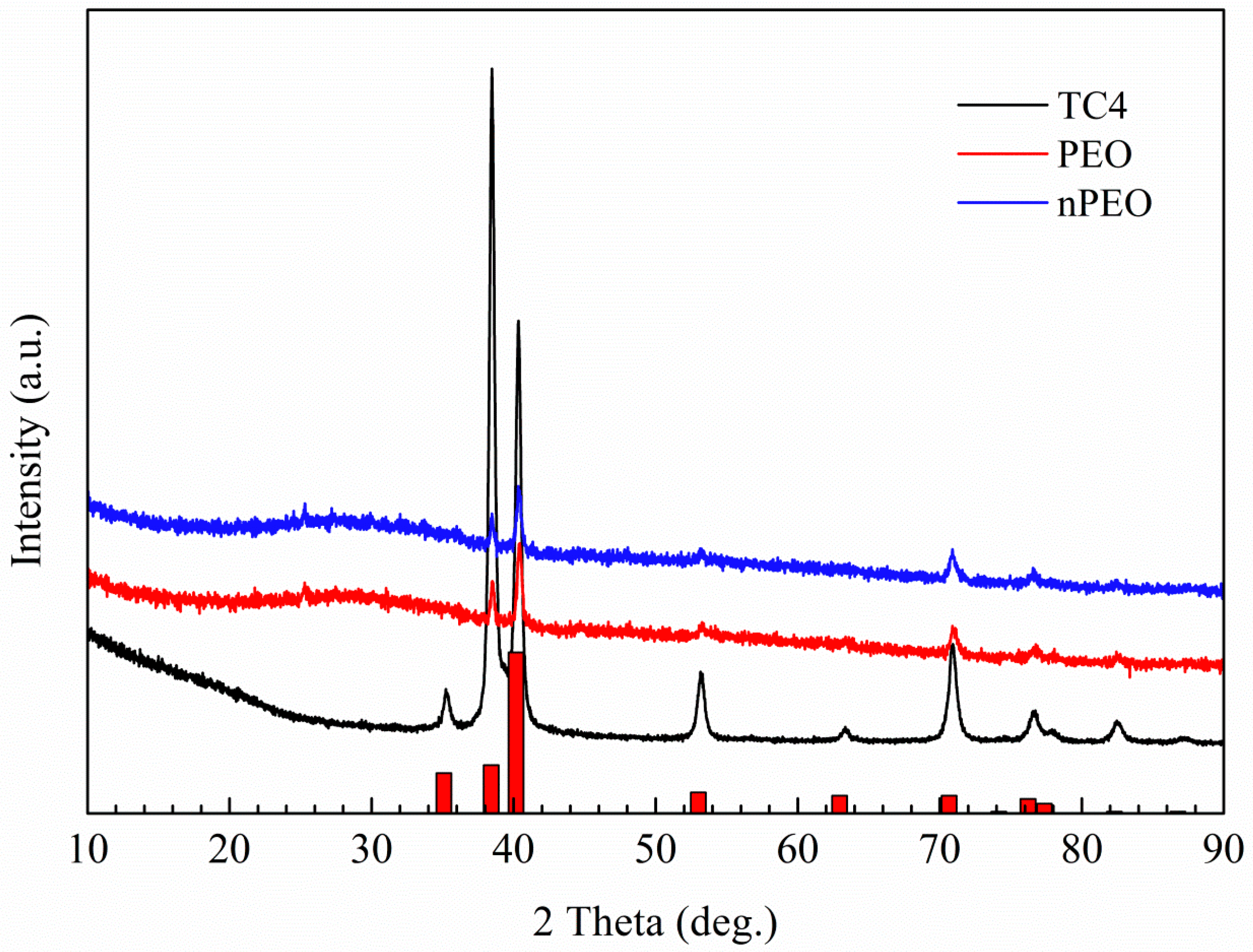

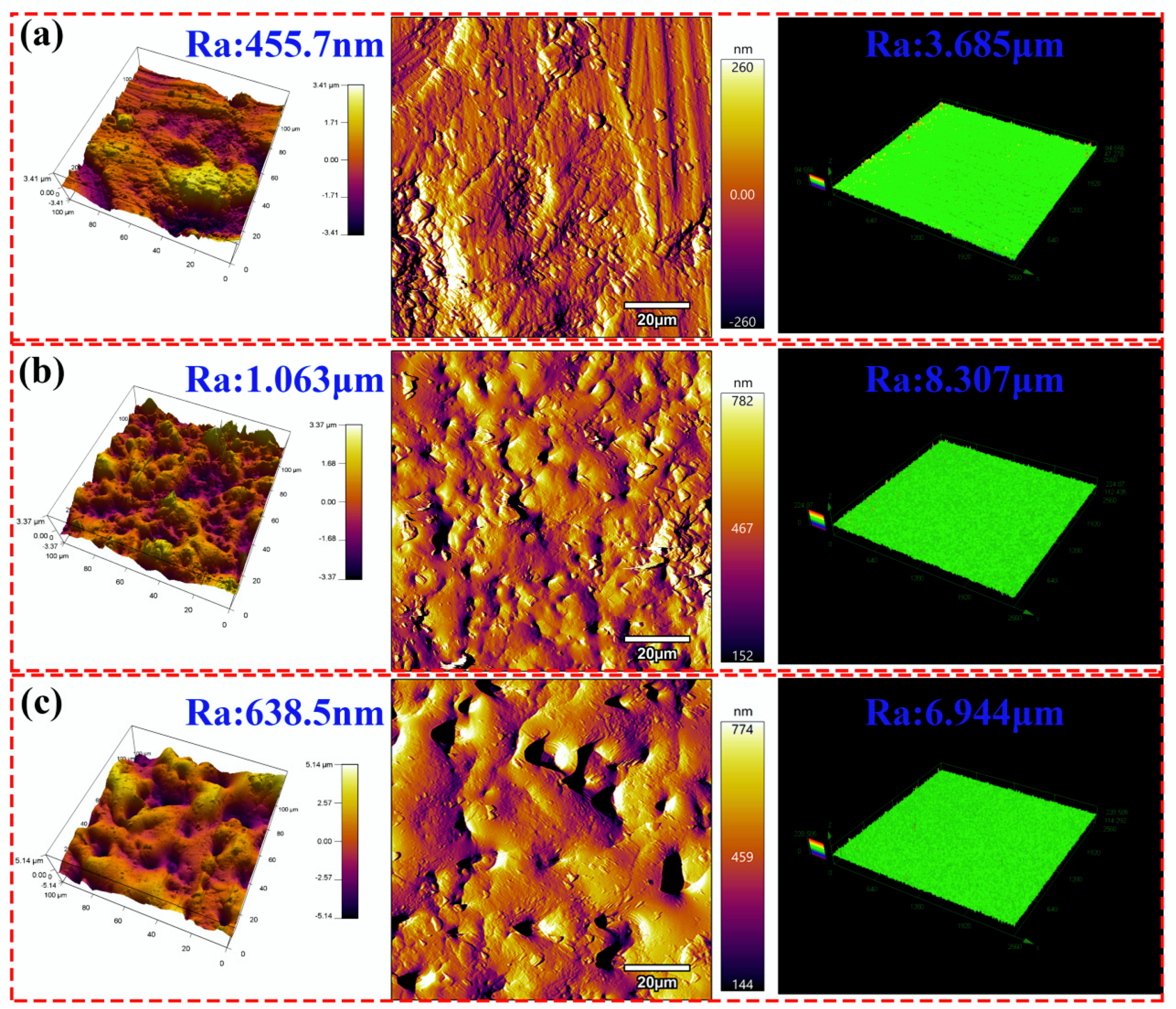


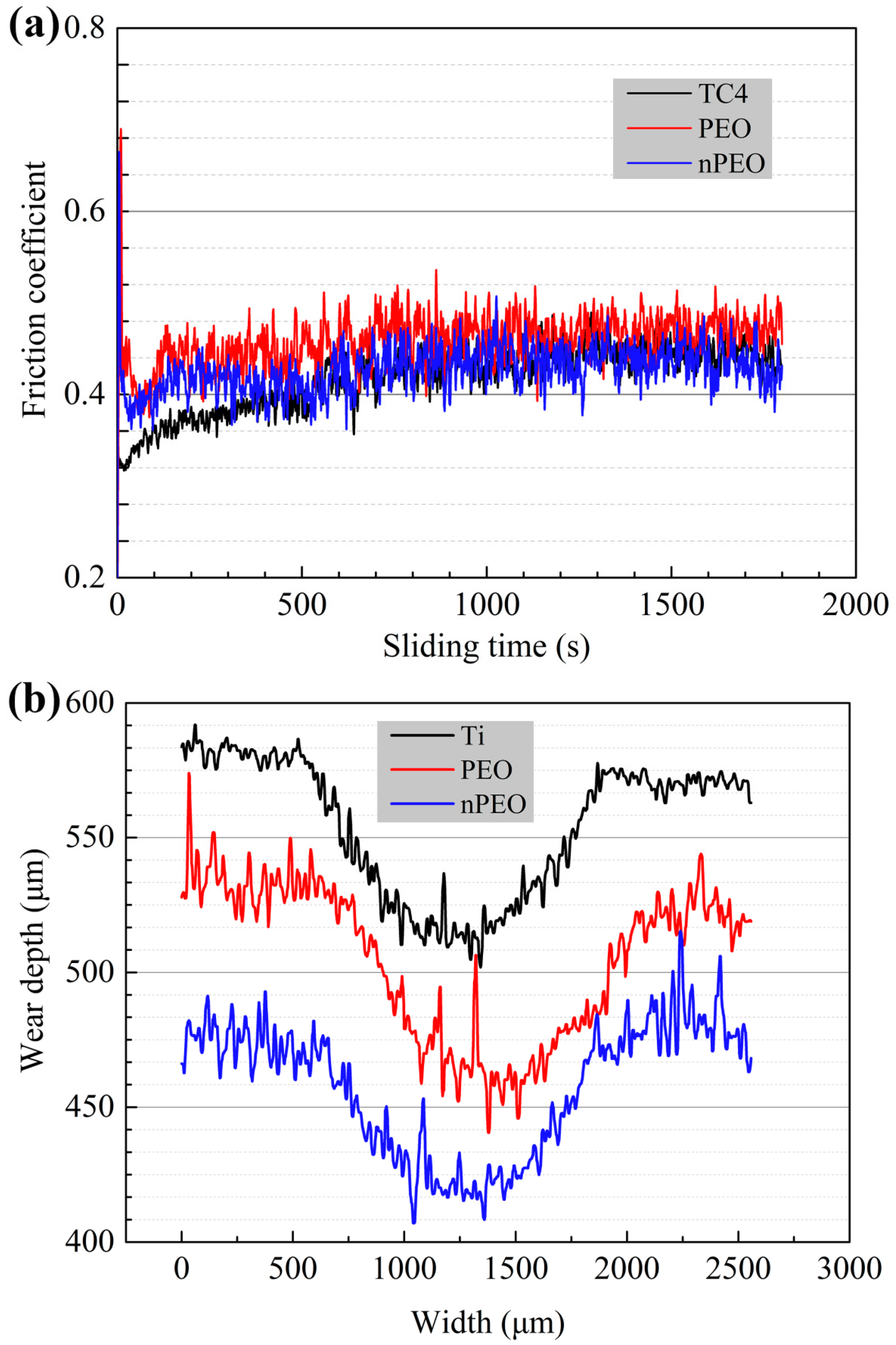

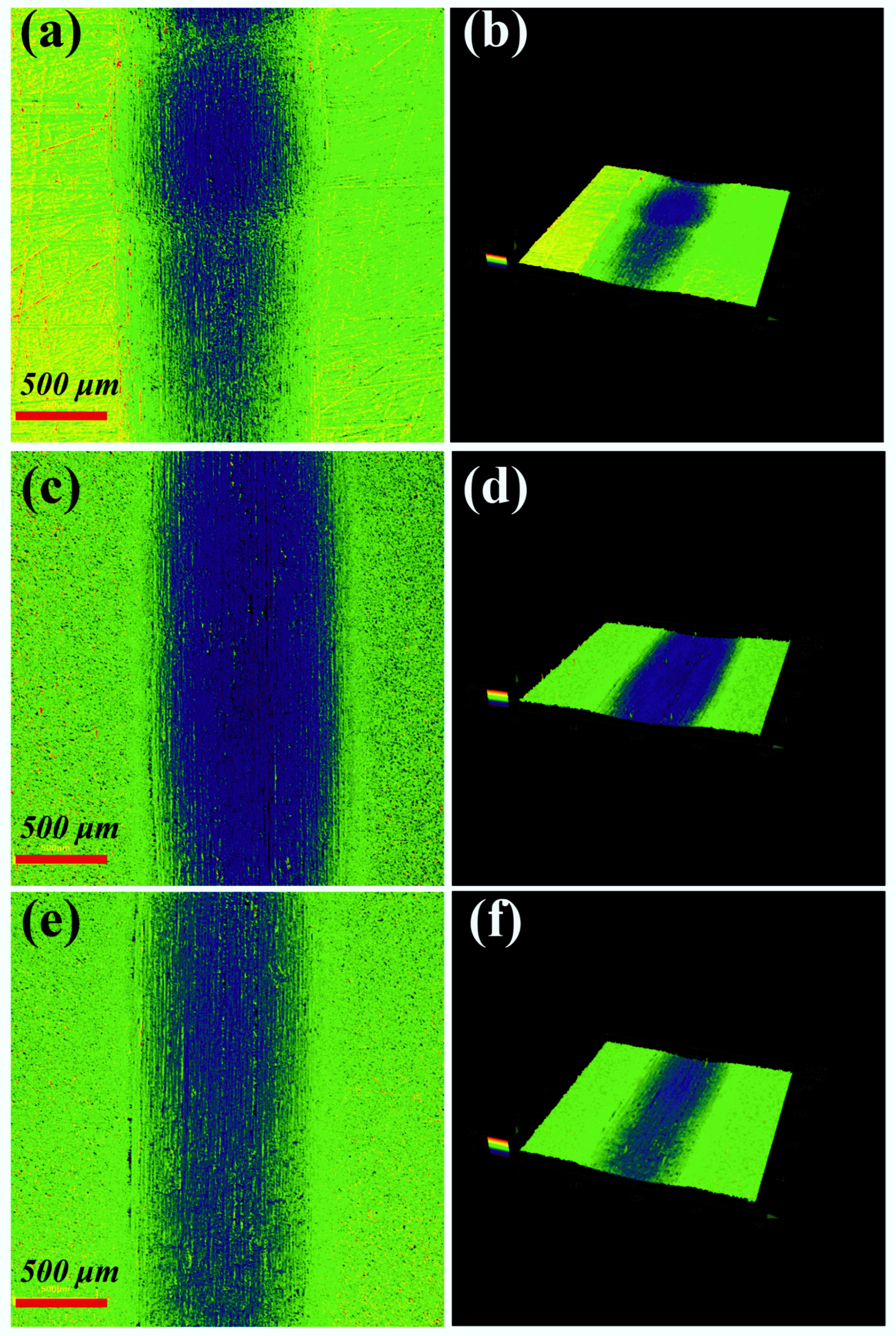
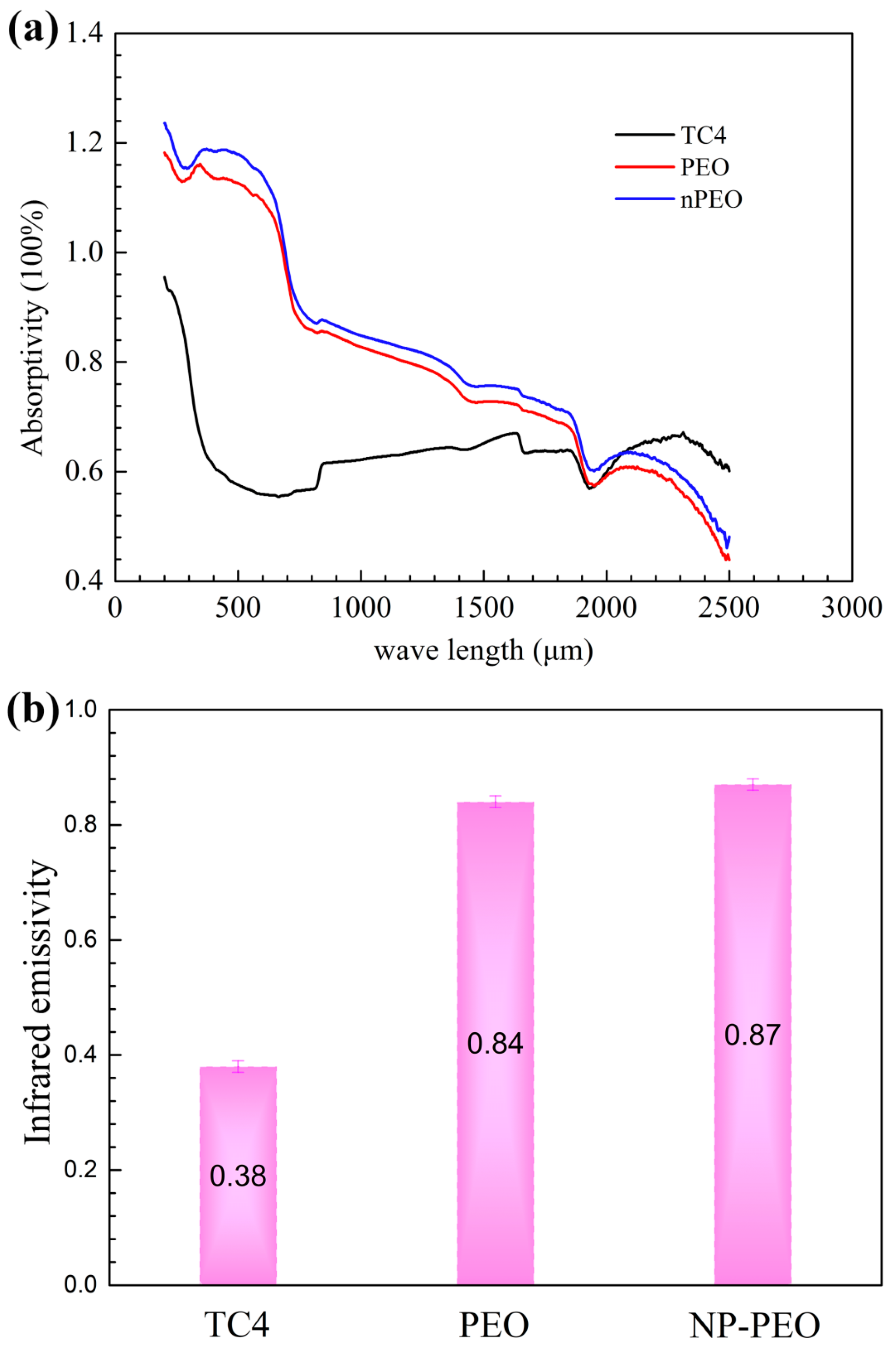
| Sample | Position | Region | O | Si | P | Ti | Fe | Mo |
|---|---|---|---|---|---|---|---|---|
| PEO | Surface | 1 | 63.1 | 0.14 | 18.56 | 16.92 | 1.16 | 0 |
| 2 | 65.77 | 0.18 | 17.2 | 15.12 | 1.26 | 0 | ||
| Cross-section | 1 | 65.3 | 0.05 | 18.21 | 15.23 | 0.85 | 0 | |
| 2 | 71.3 | 0.08 | 8.32 | 20.25 | 0.34 | 0 | ||
| nPEO | Surface | 3 | 56.5 | 2.84 | 18.61 | 19.8 | 1.91 | 0.34 |
| 4 | 53.04 | 3.71 | 20.82 | 20.34 | 1.9 | 0.17 | ||
| Cross-section | 3 | 57.68. | 3.03 | 20.32 | 16.78 | 1.85 | 0.28 | |
| 4 | 68.21 | 1.36 | 7.85 | 19.98 | 0.96 | 0.13 |
Disclaimer/Publisher’s Note: The statements, opinions and data contained in all publications are solely those of the individual author(s) and contributor(s) and not of MDPI and/or the editor(s). MDPI and/or the editor(s) disclaim responsibility for any injury to people or property resulting from any ideas, methods, instructions or products referred to in the content. |
© 2024 by the authors. Licensee MDPI, Basel, Switzerland. This article is an open access article distributed under the terms and conditions of the Creative Commons Attribution (CC BY) license (https://creativecommons.org/licenses/by/4.0/).
Share and Cite
Zhang, H.; Zhu, J.; Xia, J.; Sun, S.; Han, J. Wear and Optical Properties of MoSi2 Nanoparticles Incorporated into Black PEO Coating on TC4 Alloy. Coatings 2025, 15, 21. https://doi.org/10.3390/coatings15010021
Zhang H, Zhu J, Xia J, Sun S, Han J. Wear and Optical Properties of MoSi2 Nanoparticles Incorporated into Black PEO Coating on TC4 Alloy. Coatings. 2025; 15(1):21. https://doi.org/10.3390/coatings15010021
Chicago/Turabian StyleZhang, Hao, Jiayi Zhu, Jingpeng Xia, Shang Sun, and Jiaping Han. 2025. "Wear and Optical Properties of MoSi2 Nanoparticles Incorporated into Black PEO Coating on TC4 Alloy" Coatings 15, no. 1: 21. https://doi.org/10.3390/coatings15010021
APA StyleZhang, H., Zhu, J., Xia, J., Sun, S., & Han, J. (2025). Wear and Optical Properties of MoSi2 Nanoparticles Incorporated into Black PEO Coating on TC4 Alloy. Coatings, 15(1), 21. https://doi.org/10.3390/coatings15010021




